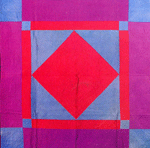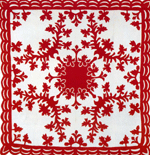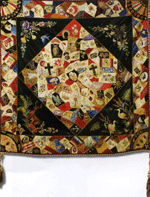|
Learn the Many Names and Types of Quilts
By Anne Gilbert
Would you recognize an Amish quilt if you saw one? What about a Kapa or a
Crazy quilt? Or a Trapunto quilt? These are but a few of the many names that
describe the techniques used in quilt making. With prices for some of the more
unusual antique quilts ranging over $1,000, it pays to not only recognize
techniques, but also to know whether the quilt was made in the 19th or 20th
century. Prices have gone up for the "Crazy" quilt that for many years couldn't
make it to major auction houses. Not so today if the designs and materials are
unusual.
One of the earliest forms of quilting that began in 14th century
Italy found its way to America. This technique was used here from 1800 through
the Civil War. Two layers of cloth were stitched together with a design. Popular
motifs were flowers and vines. When used with batting stuffed in the largest
design areas, it had a raised "quilted" look.
CLUES: Album quilts are among
the most expensive and rare. They were made in Baltimore, Md., between 1846 and
1854. The name Album was taken from the then popular hobby of putting mementoes
into scrapbooks. The album quilt used the same idea with cloth squares. Each of
the squares had a central motif, such as an animal or flowering tree. Other
subjects for the squares used identifiable Baltimore buildings, religious motifs
and geometric designs. What makes them so special is the intricate piecing and
appliqué work. For the special album bridal quilts, the stitches were almost
invisible. Each square was supposedly made by a different friend of the bride
and autographed by the maker in India ink.
Crazy quilts are a good example
of unusual quilt names, based on the fact they originally had no fixed design
when first made in the American Colonies. They were put together with whatever
fabric scraps were on hand, fitted together like a picture puzzle. As cloth
became more available in the Colonies, the Crazy quilt became a thing of the
past. When the Crazy quilt technique was revived in the 1870s, it was totally
different and introduced such fabrics as velvet, cotton, wool and silk, as well
as plush, satin and linen. The name was changed to "Crazy Patch Quilt."
Each
colorful block was hand-sewn to a backing of coarsely woven material. Once sewn
together, they were connected with fancy stitches in variously colored threads.
Advertisements or pictures printed on satin and woven silk political badges were
often used, as well as embroidered flowers, bugs and names.
Amish quilts are
defined by their use of large geometric designs and bold color combinations, as
are Mennonite quilts. Printed fabrics were rarely used. Amish crib quilts can be
super expensive, not only because not many were made, but few have survived. Log
Cabin quilts are easily recognized since part of their designs always resembles
the logs that were stacked in pioneer homes. As such, they are symbolic of the
actual log cabins. The center square is usually red, representing the placement
of a fireplace or hearth. They were popular in the late 19th century.
A Show
quilt can also be a Crazy or a Log Cabin quilt. They were made in those styles,
but strictly for display and of silk. Other popular patterns such as the "Star
of Bethlehem" were transformed into silk show quilts.
A most fascinating and
lesser known type is the Hawaiian (Kapa) quilt. It was a spin-off from
missionaries' patchwork quilts and made of two whole pieces of material,
appliquéd in a freestyle island motif, usually a single color on white. Pattern
designs included the breadfruit, turtles, ferns, crescent moon and baskets of
flowers.
Patriotic or Freedom quilts always surfaced in times of war or
surrounding some historical event, such as the 1876 Centennial. They used such
symbols as the Stars and Stripes, American heroes and statesmen. The most
popular symbol was the American bald eagle. Many quilters commemorating the 1976
Bicenten-nial used the eagle as the primary motif. If you discover one of these,
put it away as a future collectible.
|

Amish pieced wool quilted
coverlet, circa 1920.
(Photo: Private
collector)

Hawaiian appliquéd cotton quilted coverlet, circa 1930.
(Photo:
Christie's.)

Crazy quilt in silks, satins, and patterned ribbons outlined in gold feather
stitch. Embroidered in various motifs; silk cording and matching
tassels.
(Photo: Garth's Auctions.) |